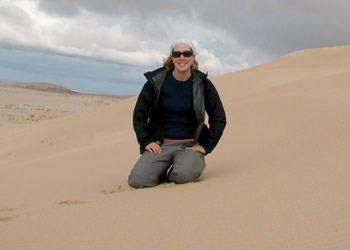"Of course," says Sarah Vinge, conservationist with Nature Saskatchewan. "Surprise, adventure and excitement - it's all part of the job."
One summer day, Vinge and a group of summer students were going through the usual drill about plant identification - the requirement for detailed observation, the match between that observation and the characteristics of a given species.
"Come and see," one of the workers called out pointing at a plant and than at her guide book.
"We think it might be a Slender Mouse Ear Cress," someone said. Vinge was skeptical.
"We know it shouldn't be," another said in reply, "but it looks the same."
Meticulously, Vinge and her employees went through the list of characteristics of the threatened species: a plant10-35 cm high, small white flowers with four petals, and toothed leaves with branched hairs.
What excitement! Not only was the plant the oddly named Slender Mouse Ear Cress, but the students had located it at a site further east than it had ever been found in the past.
Nothing typical about the plant. Nothing typical about the day either.
Other encounters were not quite as surprising - at least to a plant conservationist. During her first summer with Nature Saskatchewan, Vinge was hiking through a pasture south of the South Saskatchewan River near Burstall. She stepped through the grass and looked at the sandy soil. That's when she heard it - the rattle that meant danger.
"I just went around the snake," Vinge says. Her matter-of-fact approach to the rattler said the land was the snake's territory, not hers.
"No one from Nature Saskatchewan," she adds, "has ever had a bad encounter with a rattle snake."
Another surprising encounter came the field season of 2011, a wet year if there ever was one. Vinge and her team were in a dry sandy area of the province and that's where they found the toads. Not one or two, but floods of the amphibious creatures.
"There were toads everywhere in an area where there were no lakes, no streams, no wetlands. In fact it was hard to walk without stepping on them. The rain meant it was simply a good year for toads."
Over her four adventurous years with Nature Saskatchewan, Vinge has seen a number of threatened species: Burrowing Owls, Loggerhead Shrikes, Ferruginous Hawks and Leopard Frogs.
But more than a love of nature and its surprises, Vinge's work is with people. It is her job to approach the farmer or rancher about preserving the habitat where a threatened species grows.
"Some take a hands-off approach," she explains, "but most are enthusiastic. They want to see the plant and ask questions. They are proud when I tell them they have practiced good soil management and that's why the species continues to grow on their land. Most often, they want to work with us in conservation."
And of course, for Sarah Vinge and the folks at Nature Saskatchewan, that is when the work of the plant conservationist is its most exciting.




